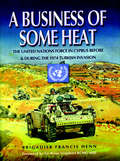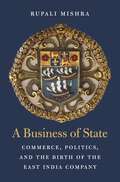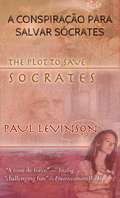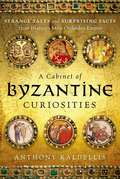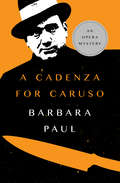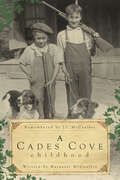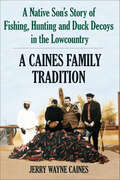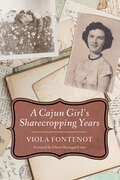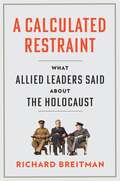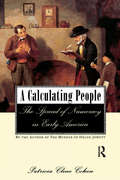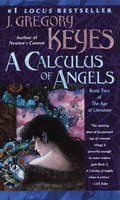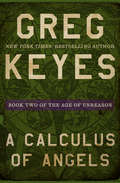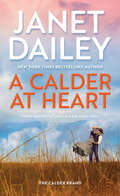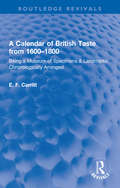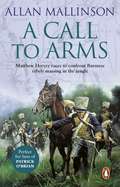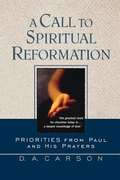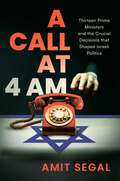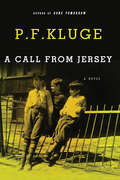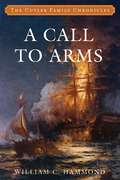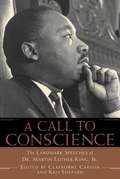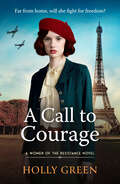- Table View
- List View
A Business of Some Heat: The United Nations Force in Cyprus Before and During the 1974 Turkish Invasion
by Brigadier Francis HennThe island of Cyprus, long troubled by inter-communal strife, exploded onto the world stage with the Athens-inspired coup against President Makarios and Turkey's invasion that followed. This resulted in the partition of the Island, which was policed by UNFICYP under the most testing conditions. These dramatic events are described here for the first time in this book which examines the political and military background, the Greek and Turkish forces and the make-up and operations of the multi-national UN Force. The difficult situation was further complicated by the Yom Kippur War and the rapid despatch of a significant part of UNFICYP to Egypt.
A Business of State: Commerce, Politics, and the Birth of the East India Company (Harvard historical studies #188)
by Rupali Mishra MishraAt the height of its power around 1800, the English East India Company controlled half of the world’s trade and deployed a vast network of political influencers at home and abroad. Yet the story of the Company’s beginnings in the early seventeenth century has remained largely untold. Rupali Mishra’s account of the East India Company’s formative years sheds new light on one of the most powerful corporations in the history of the world. From its birth in 1600, the East India Company lay at the heart of English political and economic life. The Company’s fortunes were determined by the leading figures of the Stuart era, from the monarch and his privy counselors to an extended cast of eminent courtiers and powerful merchants. Drawing on a host of overlooked and underutilized sources, Mishra reconstructs the inner life of the Company, laying bare the era’s fierce struggles to define the difference between public and private interests and the use and abuse of power. Unlike traditional accounts, which portray the Company as a private entity that came to assume the powers of a state, Mishra’s history makes clear that, from its inception, the East India Company was embedded within—and inseparable from—the state. A Business of State illuminates how the East India Company quickly came to inhabit such a unique role in England’s commercial and political ambitions. It also offers critical insights into the rise of the early modern English state and the expansion and development of its nascent empire.
A Buss from Lafayette
by Dorothea JensenFourteen-year-old Clara Hargraves lives on a farm in Hopkinton, a small New Hampshire town, during the early 19th century. She has a couple of big problems. First of all, she has a stepmother, Priscilla, who used to be her spinster schoolteacher aunt. Clara resents that her late mother's older sister has not only married her father but is about to have a baby. To make matters worse, "Prissy Priscilla" keeps trying to make the rambunctious, clever, and witty Clara act like a proper young lady. Secondly, Clara has red hair, making her a target for teasing by a handsome older boy, Dickon Weeks, and by her pretty seventeen-year-old Dread Cousin Hetty. Clara, however, has a secret plan she hopes will change this. During the last week of June, 1825, Clara's town is abuzz because the famous General Lafayette is about to visit their state during his farewell tour of America. In those eventful seven days, Clara learns a lot about her family, Hetty, Dickon, herself, and about Lafayette. She comes to understand the huge and vital role the young French aristocrat played in America's Revolutionary War and to see that her problems might not be quite so terrible after all.
A CONSPIRAÇÃO PARA SALVAR SÓCRATES
by Paul Levinson Vasco BentoUma jovem académica recebe um fragmento de um diálogo que refere um encontro entre Sócrates e um estrangeiro, que o visitou na prisão antes de beber a cicuta. Este propõe-lhe resgatá-lo e deixar um clone no seu lugar. Outras personagens entram também em contacto com esse diálogo , entre eles um inventor que criou uma cadeira para viajar no tempo. Irá Sócrates ser salvo? Quem vai sobreviver àquela corrida contra o tempo?
A Cabinet of Byzantine Curiosities: Strange Tales and Surprising Facts from History's Most Orthodox Empire
by Anthony KaldellisWeird, decadent, degenerate, racially mixed, superstitious, theocratic, effeminate, and even hyper-literate, Byzantium has long been regarded by many as one big curiosity. According to Voltaire, it represented "a worthless collection of miracles, a disgrace for the human mind"; for Hegel, it was "a disgusting picture of imbecility." A Cabinet of Byzantine Curiosities will churn up these old prejudices, while also stimulating a deeper interest among readers in one of history's most interesting civilizations. Many of the zanier tales and trivia that are collected here revolve around the political and religious life of Byzantium. Thus, stories of saints, relics, and their miracles-from the hilarious to the revolting-abound. Byzantine bureaucracy (whence the adjective "Byzantine"), court scandals, and elaborate penal code are world famous. And what would Byzantium be without its eunuchs, whose ambiguous gender produced odd and risible outcomes in different contexts? The book also contains sections on daily life that are equally eye-opening, including food (from aphrodisiacs to fermented fish sauce), games such as polo and acrobatics, and obnoxious views of foreigners and others (e.g., Germans, Catholics, Arabs, dwarves). But lest we overlook Byzantium's more honorable contributions to civilization, also included are some of the marvels of Byzantine science and technology, from the military (flamethrowers and hand grenades) to the theatrical ("elevator" thrones, roaring mechanical lions) and medical (catheters and cures, some bizarre). This vast assortment of historical anomaly and absurdity sheds vital light on one of history's most obscure and orthodox empires.
A Cabinet of Medical Curiosities
by Jan BondesonIn this book of amazing oddities, Jan Bondeson explores unexpected, gruesome, and bizarre aspects of the history of medicine. He regales us with stories of spontaneous human combustion; vicious tribes of tailed men; the Two-Headed Boy of Bengal; Mary Toft, who allegedly gave birth to seventeen rabbits; and Julia Pastrana, exhibited around the world as the Ape Woman. Bondeson combines an historian's skill in showing us our timeless fascination with the grotesque with a physician's diagnostic abilities, as he examines the evidence and provides likely explanations for these peculiar events. "Fascinating. . . . Well-researched and extensively illustrated with items from [Bondeson's] personal collection, it covers a wide range of medical monstrosities, and there is something for everyone. " â " The Lancet "Entertaining in the simultaneously creepy and amusing way of a carnival sideshow. . . . Bondeson is quick to acknowledge absurdity, and his wry humor, along with his strong personal judgments, spice up the book. " â " Publishers Weekly "Bondeson . . . regards his exhibits with a careful scientist's eye, discovering misinterpreted evidence, tragic genetic mutations, and, occasionally, outright fraud. " â " Library Journal
A Cadenza for Caruso (The Opera Mysteries #1)
by Barbara PaulHistory&’s greatest tenor hunts a killer at the Metropolitan Opera in this &“hilarious&” and &“thoroughly delightful&” mystery from a Shamus Award nominee (Publishers Weekly). Giacomo Puccini has always been a flirt. When he isn&’t writing the most popular operas the world has ever known, he has an eye for the ladies, and he doesn&’t care if his wife, Elvira, knows it. But after the composer participates in a harmless bit of chitchat with a servant girl, Elvira explodes with jealousy, driving the girl from the house and spreading lies so terrible that the innocent young woman takes her own life. Puccini is left shattered, driven nearly to suicide, and only Enrico Caruso can save him. The legendary tenor lures Puccini to New York to premiere his new opera on the Metropolitan stage. At first, all goes well. But when a member of the Metropolitan family is found murdered, all signs point to Puccini as the killer. To avert a real-life tragedy, the great Caruso takes on the most challenging role of his career: detective. A Cadenza for Caruso is the 1st book in the Opera Mysteries, but you may enjoy reading the series in any order.
A Cades Cove Childhood (American Heritage)
by J. C. Mccaulley Margaret MccaulleyThe remote Smoky Mountain community of Cades Cove still lives in the memory of J.C. McCaulley, one of the few remaining former residents, who offers an exclusive glimpse into a childhood in the Cove. His stories, compiled by his wife Margaret, are a testament to a way of life long abandoned--a life before automobiles, television and perhaps too much exposure to the outside world; a life of hard work and caring for your neighbors. Join the McCaulleys in their quest to preserve the beauty, tranquility and traditions of this pristine community, and dare to dream of a way of life that encouraged independence, integrity and the courage to overcome adversity.
A Caines Family Tradition: A Native Son's Story of Fishing, Hunting and Duck Decoys in the Lowcountry
by Jerry Wayne CainesIn Winyah Bay, near Georgetown, South Carolina, the Caines family is known for three things: fishing, hunting and hell-raising.Jerry Caines and his younger brother Roy�the Caines boys�grew up following the untamed example of their grandfather, Hucks Caines, and great-uncles�collectively known as the Caines brothers�who were renowned hunting guides at Hobcaw Barony. In this book, follow two generations of hell-raising Caineses as they achieve lasting fame carving duck decoys (now collectable and worth thousands), guiding hunters in Hobcaw Barony, fishing for shad and telling tall tales of their misadventures�often staring smack down the barrel of a rifle, and getting away with it just the same. From Hucks, Sawney, Ball, Bob and Pluty to Jerry and Roy, hunting and fishing in South Carolina will never be the same.
A Cajun Girl's Sharecropping Years
by Viola FontenotWinner of the 2019 Humanities Book of the Year from the Louisiana Endowment for the HumanitiesToday sharecropping is history, though during World War II and the Great Depression sharecropping was prevalent in Louisiana's southern parishes. Sharecroppers rented farmland and often a small house, agreeing to pay a one-third share of all profit from the sale of crops grown on the land. Sharecropping shaped Louisiana's rich cultural history, and while there have been books published about sharecropping, they share a predominately male perspective. In A Cajun Girl's Sharecropping Years, Viola Fontenot adds the female voice into the story of sharecropping.Spanning from 1937 to 1955, Fontenot describes her life as the daughter of a sharecropper in Church Point, Louisiana, including details of field work as well as the domestic arts and Cajun culture. The account begins with stories from early life, where the family lived off a gravel road near the woods without electricity, running water, or bathrooms, and a mule-drawn wagon was the only means of transportation. To gently introduce the reader to her native language, the author often includes French words along with a succinct definition. This becomes an important part of the story as Fontenot attends primary school, where she experienced prejudice for speaking French, a forbidden and punishable act. Descriptions of Fontenot's teenage years include stories of going to the boucherie; canning blackberries, figs, and pumpkins; using the wood stove to cook dinner; washing and ironing laundry; and making moss mattresses. Also included in the texts are explanations of rural Cajun holiday traditions, courting customs, leisure activities, children's games, and Saturday night house dances for family and neighbors, the fais do-do.
A Calculated Restraint: What Allied Leaders Said about the Holocaust
by Richard BreitmanAn eminent historian of the Holocaust examines why Churchill, Roosevelt, and Stalin, though faced with mounting evidence of the Nazi extermination of Jews, were reluctant to speak out against the atrocities.The Allied leaders rarely spoke directly about the Holocaust in public. When Churchill and Stalin alluded to Nazi mass murder of civilians in early speeches, they said much less than they knew. Not until December 1942 did Allied governments issue a joint statement about Nazi Germany’s policy of exterminating the Jews of Europe. Roosevelt deferred his own public statement until March 1944. Why didn’t these leaders speak up sooner?Through close readings of public and private statements, Richard Breitman pieces together the competing motivations that drove each leader’s response to the atrocities. All three knew that their reactions would be politically sensitive, as Nazi propagandists frequently alleged that the Allies were fighting on behalf of Jews, and that Jews were the puppet masters behind their governments. At a time of globally prevalent antisemitism, these calumnies had force. After the German invasion of the USSR, moreover, Stalin clearly wanted to focus on the threat to the Soviet state and people. At the same time, Churchill and Roosevelt realized that complete silence would prompt accusations of willful blindness. They usually finessed this dilemma by denouncing Nazi atrocities in general, prioritizing wartime constraints over moral considerations.Timely and incisive, A Calculated Restraint sheds new light on the relationship between World War II and the Holocaust. Ultimately, the Allied leaders’ responses cannot be reduced to a matter of character. What they said—and chose not to say—about the Holocaust must be understood in light of the political and military exigencies that drove their decision-making.
A Calculating People: The Spread of Numeracy in Early America
by Patricia Cline CohenNow back in print, A Calculating People reveals how numeracy profoundly shaped the character of society in the early republic and provides a wholly original perspective on the development of modern America.
A Calculus of Angels
by J. Gregory Keyes1722: A second Dark Age looms. An asteroid has devastated the Earth, called down by dire creatures who plot against the world of men. The brilliant-- some say mad--Isaac Newton has taken refuge in ancient Prague. There, with his young apprentice Ben Franklin, he plumbs the secrets of the aetheric beings who have so nearly destroyed humanity.But their safety is tenuous. Peter the Great marches his unstoppable forces across Europe. And half a world away, Cotton Mather and Blackbeard the pirate assemble a party of colonial luminaries to cross the Atlantic and discover what has befallen the Old World. With them sails Red Shoes, a Choctaw shaman whose mysterious connections to the invisible world warn him that they are all moving toward a confrontation as violent as it is decisive . . .From the Paperback edition.
A Calculus of Angels (The Age of Unreason #2)
by Greg KeyesIn an alternate eighteenth-century Europe devastated by alchemical disaster, Sir Isaac Newton and his able assistant, Benjamin Franklin, confront enemies who seek humankind's destruction Sir Isaac Newton's discovery of philosopher's mercury in 1681 gave rise to a remarkable new branch of alchemical science. Forty years later, the world stands poised on the brink of a new dark age . . . England is in ruins, crushed by an asteroid called to Earth by the very alchemy Newton unleashed. France is in chaos following the long-delayed death of Louis XIV. Cotton Mather, Blackbeard, and the Choctaw shaman Red Shoes set sail from the American colonies to investigate the silence lying over the Old World. And in Russia, Tsar Peter the Great, now host to the evil entity that kept the Sun King alive, seizes a golden opportunity for conquest as he marches his unstoppable army across a devastated continent. Meanwhile Newton and his young apprentice, Ben Franklin, hide out in Prague, awaiting the inevitable violent collision of all these disparate elements--human and demonic alike--while a fugitive Adrienne de Mornay de Montchevreuil pursues the secrets of the malakim and her own role in their conspiracy to obliterate humankind. The second volume of the Age of Unreason series, Greg Keyes's masterwork of alternate history, A Calculus of Angels brilliantly expands the scope of the world he introduced in Newton's Cannon as an unforgettable cast of historical heavyweights collide on a different Earth where magic and science coexist.
A Calder at Heart (The Calder Brand #3)
by Janet DaileyIn a tale perfect for fans of Yellowstone, the legendary New York Times bestselling author brings America&’s frontier to vivid life in a saga of love, hope and endurance in 1919 Montana, as the end of the Great War, the looming start of Prohibition, and reignited rivalries put a small town on the brink of a seismic shift. Now in mass market for the first time! &“Dailey keeps the pace brisk with dangers both natural and man-made, and her battle-scarred protagonists are easy to root for.&” – Publishers Weekly Battle-scarred and emotionally ravaged by the loss of his wife and children to Spanish flu, former US Army Major Logan Hunter heads to Blue Moon to salvage whatever peace he can near the only family he has left. Not only does the Calder clan embrace him, but patriarch Webb Calder helps Logan secure a prime piece of ranching property. Yet settling into his new home is fraught with challenges, especially since Logan&’s land borders the rival Dollarhide spread, stoking the battle between the families anew and pitting Logan against an adversary who stirs him like no other . . . From her first encounter with Logan Hunter, Dr. Kristin Dollarhide feels an instant connection to the sorrow in his beautiful eyes. As a former military MD, Kristin is no stranger to the devastating effects the war has left on hearts and minds—including her own. Despite her instinct to steer clear, Kristin is powerfully drawn to the handsome widower. Until the raging conflict takes a tragic turn, threatening all hope for their future . . .The epic tale of the settling of the American West comes to vivid life in this inspiring saga of love, hope and endurance.
A Calendar of British Taste from 1600–1800: Being a Museum of Specimens & Landmarks Chronologically Arranged (Routledge Revivals)
by E. F. CarrittFirst published in 1948, A Calendar of British Taste from 1600–1800 gives a picture of British taste in art, nature and manners during the centuries 1600 to 1800. The book is an anthology from novels, poetry, letters, essays, advertisements and diaries of the period. It is arranged chronologically and covers a wide range of topics including architecture, gardens, manners, music, nature, painting, poetry, sculpture, and the stage. Key authors drawn upon include Pepys, Dryden, Pope, Horace Walpole, Dr. Johnson, Fanny Burney, Cowper, and Wordsworth. Through an extensive and panoramic view, the book traces the development and changes in taste over time. A Calendar of British Taste from 1600–1800 is ideal for anyone with an interest in the cultural and social history of Britain.
A Calgary Album: Glimpses of the Way We Were
by Mark Kozub Janice KozubBefore becoming the oil capital of the nation, Calgary was a nineteenth-century boomtown in the heart of Alberta. The roots of great prosperity were growing, despite the fact that politicians and the general public believed the West was best left to the trapper and trader. Nurtured by a sense of vision and the sweat of good old-fashioned hard work, Calgary grew, and has now blossomed into a world-class cosmopolitan city noted for its burgeoning oil and gas industry, its famed Calgary Zoo, and of course, the Stampede. A Calgary Album is a sentimental journey into a cattle town that grew to be so much more. Through sixty-five glorious black and white photographs and engaging storytelling, the authors take the reader back to the time of the "real" cowboys, to the days when the streetcar seemed like science fiction, through the Depression, the great wars, the times of boom, bust, and recovery. We revisit the movers, the shakers, and the honourable everyday people who turned this "cow town" into a city worth bragging about.
A Call To Arms: (The Matthew Hervey Adventures: 4): A rip-roaring and fast-paced military adventure from bestselling author Allan Mallinson (Matthew Hervey #4)
by Allan MallinsonThe Sunday Times bestselling author Allan Mallinson, brings us another action-packed and stirring Matthew Hervey adventure. If you like Patrick O'Brian, Bernard Cornwell and CS Forester, this will not disappoint!"A thoroughly satisfying and entertaining read" - THE TIMES"Matthew Hervey has now joined Bernard Cornwell's Sharpe and Patrick O'Brian's Jack Aubrey" - Birmingham Post"After just half-a-dozen pages I was hooked." -- ***** Reader review"An excellent book, when you start reading you cannot put it down. Allan Mallinson at his best!!!" -- ***** Reader review"Essential reading for military buffs" -- ***** Reader review**********************************************************************India 1819: Matthew Hervey is charged with raising a new troop, and organising transport for India - for he, his men and their horses are to set sail with immediate effect.What Hervey and his soldiers cannot know is that in India they will face a trial for which they are woefully under prepared. A large number of Burmese war-boats are assembled near Chittagong, and the only way to thwart their advance involves a hazardous march through the jungle. Soon Hervey and his troop are in the midst of hot and bloody action once again...A Call To Arms is the fourth book in Allan Mallinson's Matthew Hervey series. His adventures continue in The Sabre's Edge. Have you read his previous adventures A Close Run Thing, The Nizam's Daughters and A Regimental Affair?
A Call To Spiritual Reformation: Priorities From Paul And His Prayers
by D. A. CarsonCarson's clarion call to a failing church is that Paul's prayer life must transform Christians if they are to know release from the superficial. Carson calls leaders to turn from focusing on frenetic activity and meaningless emotion and instead teach their people to intimately know God and His power.
A Call at 4 AM: Thirteen Prime Ministers and the Crucial Decisions that Shaped Israeli Politics
by Amit SegalThe full and untold story of Israeli politics penned by one of Israel&’s most distinguished political journalists.&“The phones had been installed in every corner of the apartment, and all started ringing at once. Golda Meir knew exactly what the sound meant—but she was afraid to pick up. Then she woke up with a jolt, covered in a cold sweat. It was 4 AM, and she could not get back to sleep.&”In A Call at 4 AM, Israel&’s top political journalist, Amit Segal, takes you inside the moments when history was decided in real time. From Golda Meir&’s sleepless nights before the Yom Kippur War to Benjamin Netanyahu&’s power struggles during missile attacks, Segal uncovers the untold stories of war rooms, last-minute deals, and the relentless pressure of governing a country that never knows a quiet day.Through gripping storytelling and unprecedented access, Segal reveals how Israel&’s leaders navigate wars, terror waves, and global crises—while constantly fighting for their own political survival. What happens behind closed doors when a prime minister must decide whether to strike Iran? How do backroom betrayals and coalition battles shape military decisions? And why, in Israel, is every political crisis also a national emergency?Witty, fast-paced, and packed with revelations, A Call at 4 AM is the closest you&’ll ever get to standing in the prime minister&’s shoes when the phone rings—and the fate of Israel is on the line.
A Call from Jersey: A Novel
by P. F. KlugeWith A Call From New Jersey Kluge has outdone himself with a long view of the American experience and the steady mutation of the American dream. Set in the1980's it follows the life of Hans Greifinger, a German-American who immigrated to the United States in 1928 and built a life for himself and his son, George, who has adopted the surname Griffin for his nationally-syndicated lackluster travel column. .
A Call to Arms (Cutler Family Chronicles)
by William C. HammondA Call To Arms, the fourth novel in the award-winning Cutler Family Chronicles by William C. Hammond, features the epic saga of the seafaring Cutler family of Hingham, Massachusetts, and an ever expanding cast of characters, including real historical figures Captain Edward Preble, Lieutenant Stephen Decatur, Lieutenant Richard Somers, Samuel Coleridge, Bashaw Yusuf Qaramanli, and Admiral Horatio Lord Nelson. Interwoven with these historical characters is a fast-paced and gripping plot that takes the reader from Java in the Dutch East Indies to New England at the start of the nineteenth century, and on to Gibraltar, Tripoli, Malta, Sicily, Alexandria, and Cairo. Set primarily in the Mediterranean Sea during the First Barbary War (1801–1805), A Call To Arms offers the reader intriguing and often startling insights into a young republic's struggle to promote its principles of liberty, equality, and free trade in a world ravaged by the Napoleonic Wars in Europe and ruthless piracy in both the Mediterranean and Far Eastern waters. The US Navy answers the call of an aroused nation, and the fate of the young republic turns on the actions of a few heroic officers, sailors, and Marines.
A Call to Conscience: The Landmark Speeches of Dr. Martin Luther King, Jr.
by Clayborne Carson Kris Shepard Andrew YoungThis companion volume to "A Knock At Midnight: Inspiration from the Great Sermons of Rev. Martin Luther King, Jr". includes the text of his most well-known oration, "I Have a Dream", his acceptance speech for the Nobel Peace Prize, and "Beyond Vietnam", a powerful plea to end the ongoing conflict. Includes contributions from Rosa Parks, Aretha Franklin, the Dalai Lama, and many others.
A Call to Courage: A powerfully captivating and romantic WW2 saga (Women of the Resistance)
by Holly GreenFar from home, will she fight for freedom? 21-year-old Alix is studying in Paris, far away from Sasha, her Serbian father and Leonora, her English mother, as World War Two breaks out. Finding hope even in troubled times, romance sparks with fellow student Raoul; but she soon learns young love can be tumultuous. So, when Steve, a handsome American pilot with Serbian ancestors, enters her life, she can’t ignore her feelings toward him. And making a decision will be even harder as both men leave for war… Meanwhile, in Belgrade her father is embroiled in a plot against the Prince Regent, while her mother begins to work with the Nursing Corps in Finland. Life in Paris grows perilous under the oppressive German occupation, and Alix is faced with an impossible choice: run for home, or stay and join the Resistance. Can she find the courage to risk her life for freedom? Meet the characters from Holly Green’s Frontline Nurses series, in this captivating new historical read set in Paris during WW2. Fans of Amanda Lees and Suzanne Kelman will love this. Readers are absolutely hooked: ‘So well written… felt so real. Everything about it made for a great read. I recommend this and give it 5 stars.’ ***** Reader Review ‘A fantastic story … The characters capture your attention right from the very first page.' ***** Reader Review ‘The story had me hooked from the beginning … highly recommend’ ***** Reader Review ‘Great book by this author … felt like I was in the story’ ***** Reader Review Praise for Holly Green: ‘Holly Green’s research and delivery of her stories gives readers a glimpse of the reality of war.’ ***** Reader Review ‘Holly’s storytelling is amazing, you feel you are actually there.’ ***** Reader Review
A Call to Home: A captivating, romantic and poignant WW2 novel (Women of the Resistance)
by Holly GreenWill she risk everything, to save those she loves most? Alix has always been on the side of the Resistance. Over two years of danger and suffering, she has continued the fight alongside her comrades in the Partisans. But while facing constant threat, her personal relationships, with Nikola – the man she was supposed to marry – and Drago, her lifelong friend, are complicated. Working with the rival Chetniks is Steve, the American pilot who is never far from Alix’s mind. Despite wanting the same peaceful outcome, they remain on opposite sides. The hope of a reunion seems unlikely, but nothing is ever predictable in love and war… Featuring characters from Holly Green’s Frontline Nurses series, this gripping new historical read spans Europe during World War Two. Fans of Amanda Lees and Fiona Valpy will love this captivating wartime romance. Readers love Holly Green’s Women of the Resistance series: 'I was captured from the beginning as the characters were instantly familiar.'***** Reader Review ‘So well written… felt so real. Everything about it made for a great read. I recommend this and give it 5 stars.’ ***** Reader Review ‘A fantastic story … The characters capture your attention right from the very first page.’ ***** Reader Review ‘The story had me hooked from the beginning … highly recommend’ ***** Reader Review ‘Great book by this author … felt like I was in the story’ ***** Reader Review ‘A brilliantly written and well researched book.’ ***** Reader Review ‘Holly’s storytelling is amazing, you feel you are actually there.’ ***** Reader Review ‘Holly Green’s research and delivery of her stories gives readers a glimpse of the reality of war.’ ***** Reader Review
